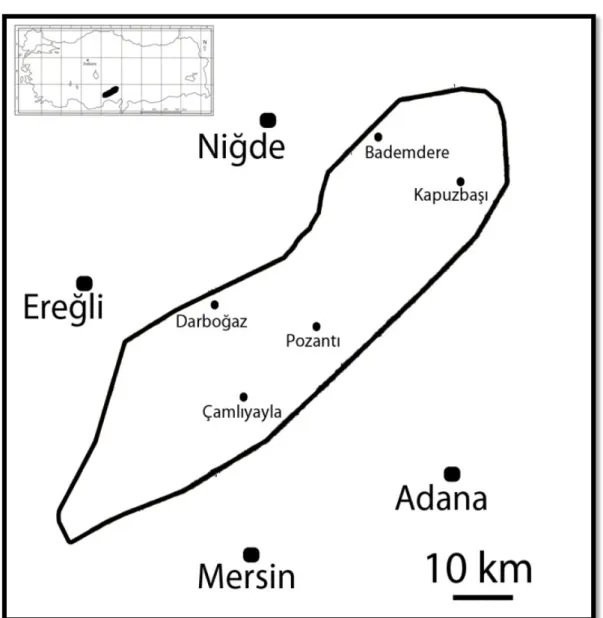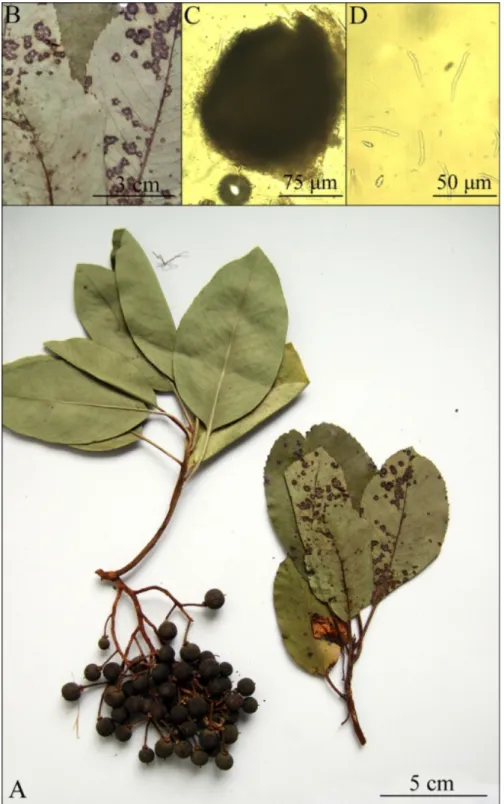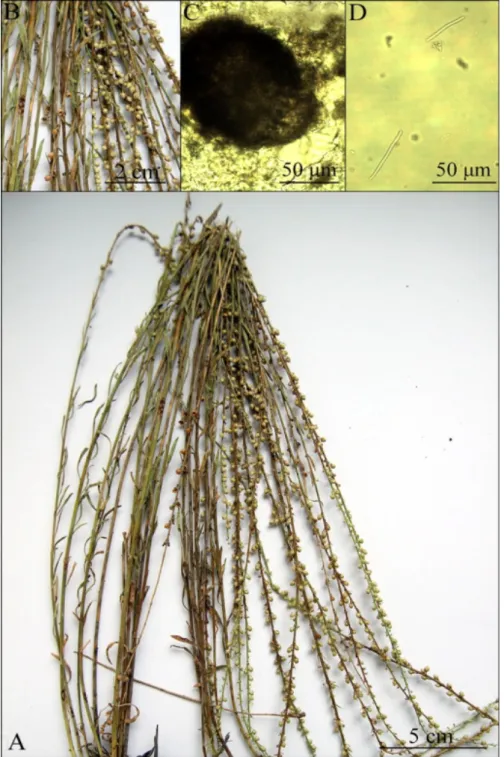142
Geliş(Recevied) :26/04/2018Kabul(Accepted) :02/07/2018
Research Article Doi:10.30708/mantar.418912
Septoria Sacc. (Mycosphaerellales) Species Determined in
Aladağlar and Bolkar Mountains (Turkey)
Şanlı KABAKTEPE
1, Ilgaz AKATA*
2*Corresponding author:akata@science.ankara.edu.tr
1Malatya Turgut Özal University, Battalgazi Vocat Sch., Battalgazi, Malatya, Turkey 2Ankara University, Faculty of Science, Department of Biology, Ankara, Turkey
Abstract: In the current study, nine Septoria species were determined in Aladağlar and Bolkar Mountains (Turkey) on the ten different host plants. Among them, Septoria alnicola Cooke on Alnus glutinosa (L.) Gaertn. (Betulaceae) and Septoria antirrhini Desm. on Antirrhinum majus L. (Plantaginaceae) are new records for Turkish mycobiota and also Cyclamen cilicium is the new host for Septoria cyclaminis Durieu & Mont. Short descriptions of the newly reported species were provided together with macro and microphotographs and discussed briefly.
Key words: Septoria, Aladağlar, Bolkar mountains, New records, Turkey
Aladağlar ve Bolkar Dağları’ndan Belirlenen Septoria Sacc.
(Mycosphaerellales) Türleri
Öz: Mevcut çalışmada, Aladağlar ve Bolkar Dağları’ndan (Türkiye) 10 farklı konakçı bitki
üzerinden 9 Septoria türü belirlenmiştir. Bu türlerden Alnus glutinosa (L.) Gaertn. (Betulaceae) üzerinde Septoria alnicola Cooke ve Antirrhinum majus L. (Plantaginaceae) üzerinde Septoria
antirrhini Desm. Türkiye mikobiyotası için yeni kayıttır ve ayrıca Cyclamen cilicium Boiss. & Heldr. Septoria cyclaminis Durieu & Mont. için yeni konakçıdır. Yeni kayıt olarak verilen türlere ait kısa
tanımlamalar ile makro ve mikrofotoğrafları verilerek kısaca tartışılmıştır.
Anahtar kelimeler: Septoria, Aladağlar, Bolkar Dağları, yeni kayıtlar, Türkiye
Introduction
Aladağlar and Bolkar Mountains are situated in the C5 grid square according to the system adopted by Davis (1965). The region is located in the eastern part of the Central Taurus Mountains complex in southern Anatolia and surrounded by Kayseri in the north east, Niğde and Ereğli in the north west, Karaman in the west, Mersin in the south and Adana in the south east (Figure 1). The southern slopes of the study area has the characteristics of Mediterranean climate features, while the northern slopes of the study area reflects the semi-arid climate
(Akman, 1999; Gemici, 1994).
Septoria Sacc. is an anamorphic and very large
genus of pycnidia-producing fungi causing a range of disease symptoms including leaf and fruit spots in many cultivated and wild plants. More than 3000 published names of species including many synonyms have been listed under the genus; however, some estimates of true
numbers of this genus range from 1000 to 2000 (Kirk et al., 2008; Seifbarghi et al., 2009; Verkley et al., 2013). Teleomorphs are known just for a small number of species which are classified in Mycosphaerella Johanson and
Sphaerulina Sacc. (Priest, 2006).
According to literature (Hüseyin and Selçuk, 2002; Hüseyin et al., 2016; Selçuk et al., 2009; Ekici et al., 2012; Erdoğdu et al., 2017; Kabaktepe and Bahçecioğlu, 2006; Kabaktepe et al., 2013), there is not any record of Septoria
alnicola Cooke and Septoria antirrhini Desm. in Turkey.
The purpose of the present study is to make a contribution to the Turkish mycobiota.
Materials and methods
Infected plant samples were collected from Aladağlar and Bolkar mountains (Kayseri, Niğde, Konya, Karaman, Mersin, Adana) in Turkey between 2013 and 2016. Host plants were identified using the Flora of Turkey and East
143
Figure 1. Map of study area
Aegean Islands (Davis, 1965-1988). The fungal specimens were examined microscopically. Spores were scraped from dried host specimens. Macrophotographs were taken under a stereo microscope (Novex trinocular zoom stereo microscope RZT-SF). Microphotographs were taken under a light microscope (Noveks B series 1000). Analysis LS Starter software was used for sizing the spores and sporophores. The current names of fungi were given according to Url1. Names of host plants and families were given according to Url2. The microfungi were identified using the relevant literature (Saccardo 1884, Priest, 2006; Sutton, 1980). All specimens examined were kept in the Inönü University Herbarium (INU) in Malatya (Turkey). Results Ascomycota Dothideomycetes Mycosphaerellales Mycosphaerellaceae Septoria Sacc.
1. Septoria alnicola Cooke, Handb. Brit. Fungi 1:
451 (1871). Figure 2.
Spots amphigenous, rounded, 5–7 mm long, light brown-black. Pycnidia minute, 40-70 μm in diameter, scattered over the spots, semi-innate, black, pierced at the apex. Conidia oblong, attenuate both ends, straight to curved, 18–50 × 2– 3.5 μm, 1–3-septate, usually 2-septate, hyaline.
144
Specimen examined: On Alnus glutinosa (L.) Gaertn.(Betulaceae), Mersin: Tarsus, Söğütlü Village, 575 m, 08.10.2013, Ş. Kabaktepe & I. Akata 7335; Mersin: Sebil, 980 m, 26.04.2014, Ş. Kabaktepe & I. Akata 7388; Mersin: Çamlıyayla, between Olukkaya-Fakılar, 560 m,
22.05.2014, Ş. Kabaktepe & I. Akata 7482; Mersin: Çamlıyayla, Kadıncık valley, Kuzbağı located, 1300-1350 m, 26.06.2015, Ş. Kabaktepe & I. Akata 8140; Mersin: Çamlıyayla, Fakılar, Kadıncık valley 9. km, 680-700 m, 26.08.2015, Ş. Kabaktepe & I. Akata 8194.
Figure 2. S. alnicola on Alnus glutinosa A- dried herbarium specimen; B- infected plant leaves;C- LM view of Pycnidium; D- LM view of Conidiospores.
144
2. S. antirrhini Desm., Notul. Pl. Crypt.: 3, no. 2175(1825). Figure 3.
Spots amphigenous, rounded to oblong, 2–3 mm long, light brown. Pycnidia amphigenous, 45-90 μm in diameter, common, immersed, brown. Conidia cylindrical to oblong, attenuate or acute both ends,
straight to slightly curved, 15–30 × 2–2.5 μm, 4–7-septate, hyaline.
Specimen examined: On Antirrhinum majus L.
(Plantaginaceae), Niğde: Ulukışla, 8-10 km south Emirler village, 1800-1900 m, 13.07.2014, Ş. Kabaktepe & I. Akata 7528.
Figure 3. S. antirrhini on Antirrhinum majus A- dried herbarium specimen; B- infected plant; C- LM view of Pycnidium; D- LM view of Conidia
146
3. S. convolvuli Desm., Annls Sci. Nat., Bot., sér. 2 17:108 (1842).
Specimen examined: On Convolvulus arvensis L.
(Convolvulaceae), Mersin: Çamlıyayla, Kadıncık valley, Papazın bahçesi located, 820-850 m, 26.06.2015, Ş. Kabaktepe & I. Akata 8155. Mersin: Tarsus, 2 km from Gülek to Karboğazı, 1300-1350 m, 22.05.2014, Ş. Kabaktepe & I. Akata 7496; On Convolvulus sepium L. Adana, Pozantı, Akçatekir plateau, 920-1000 m, 22.05.2014, Ş. Kabaktepe & I. Akata 7502.
4. S. cyclaminis Durieu & Mont., in Montagne, Syll. gen.
sp. crypt. (Paris): 279 (1856).
Specimen examined: On Cyclamen cilicium Boiss. &
Heldr. (Primulaceae) Kayseri: Yahyalı, Kapuzbaşı waterfall, 650-700 m, 18.09.2014, Ş. Kabaktepe & I. Akata 7494.
5. S. dimera Sacc., Michelia 2 (no. 6): 102 (1880). Specimen examined: On Silene sp. (Caryophyllaceae)
Kayseri: Yahyalı, Derebağ village, 1200-1400 m, 25.09.2013, Ş. Kabaktepe & I. Akata 7165; Adana: Aladağ, Gerdibi village, 27.09.2013 Ş. Kabaktepe & I. Akata 7239.
6. S. elaeagni (Chevall.) Desm., Annls Sci. Nat., Bot., sér.
3 21: 4 (1853).
Specimen examined: On Elaeagnus angustifolia L.
(Elaeagnaceae) Mersin: Çamlıyayla, Kadıncık valley, Kozpınar located, 900-950 m, 26.06.2015, Ş. Kabaktepe & I. Akata 8136.
7. S. ornithogali Pass., in Thümen, Flora, Regensburg 60:
207 (1877).
Specimen examined: On Ornithogalum montanum Cirillo
(Asparagaceae) Kayseri, Yahyalı, Derebağ waterfall, 1270 m, 17.09.2014, Ş. Kabaktepe & I. Akata 7758; Mersin:
Çamlıyayla, Sebil, Cehennem Deresi, Pınarlıbük located, 720-780 m, 01.11.2014, Ş. Kabaktepe & I. Akata 7975.
8. S. rubiae (Pat.) Bubák & Ranoj., Annls mycol. 8(3): 390
(1910).
Specimen examined: On Rubia tinctorum L. (Rubiaceae), Kayseri: Yahyalı, Kirazlı village, 1220 m, 05.10.2013, Ş. Kabaktepe & I. Akata 7271; Konya: Halkapınar, 5 km from Kayasaray to Çakıllar,1350-1400 m, 14.07.2014, Ş. Kabaktepe & I. Akata 7564; Kayseri, Yahyalı, Derebağ waterfall, 1270 m, 17.09.2014, Ş. Kabaktepe & I. Akata 7759.
9. S. verbenae Roberge ex Desm., Annls Sci. Nat., Bot.,
sér. 3 8: 19 (1847).
Specimen examined: On Verbena officinalis L.
(Verbenaceae), Mersin: Çamlıyayla, Kadıncık valley, Kozpınar located, 900-950 m, 26.06.2015, Ş. Kabaktepe & I. Akata 8135.
Discussion
As a result of the present study, 9 Septoria species on 10 different host plant species were determined. Among them, S. alnicola (on Alnus glutinosa), and S.
antirrhini (on Antirrhinum majus) were reported for the first
time from Turkey (Table 1).
Tracing to literature on Turkish Septoria (Hüseyin and Selçuk, 2002; Hüseyin et al., 2016; Selçuk et al., 2009; Ekici et al., 2012; Erdoğdu et al., 2017; Kabaktepe and Bahçecioğlu, 2006; Kabaktepe et al., 2013) 85 species on 78 host plants have previously been reported from Turkey. With the present study, S. alnicola and S. antirrhini are recorded for Turkish Septoria for the first time and
Cyclamen cilicium was determined as a new host for S. cyclaminis. So the number of Turkish Septoria species and
host plants increased to 87 and 81 respectively.
Table1. Septoria species and their host plants determined in the study area
Species
Host species
1.
S. alnicola
Alnus glutinosa
2.
S. antirrhini
Antirrhinum majus
3.
S. convolvuli
Convolvulus arvensis
Convolvulus sepium
4.
S. cyclaminis
Cyclamen cilicium
5.
S. dimera
Silene sp.
6.
S. elaeagni
Elaeagnus angustifolia
7.
S. ornithogali
Ornithogalum montanum
8.
S. rubiae
Rubia tinctorum
9.
S. verbenae
Verbena officinalis
Acknowledgements
147
ReferencesAkman Y., İklim ve Biyoiklim (Biyoiklim Metodları ve Türkiye İklimleri), 1. Baskı, Kariyer Matbaacılık Ltd. Şti., Ankara(1999). Davis P.H. (ed.)., Flora of Turkey and the east Aegean islands, Vol. 1-10, Edinburgh Univ Press, Edinburgh(1965-1988). Ekici T, Erdoğdu M, Aytaç Z, Suludere Z., Septoria species in Kıbrıs Village Valley (Ankara, Turkey), Nova Hedwigia, 95: 483–
491(2012).
Erdoğdu M., Suludere Z, Hüseyin E., Additions to the leaf pathogenic fungi of Turkey, Plant Pathology & Quarantine, 7(1): 16– 19(2017).
Gemici, Y., Bolkar Daglarinin (Orta Toroslar) Flora ve Vejetasyonu Üzerine Genel Bilgiler, Turkish Journal of Botany, 18(2):81-89(1994).
Hüseyin E., Selçuk F., A new species of Septoria, Pakistan Journal of Botany, 34 (2):113-115(2002).
Hüseyin E., Selçuk F., Churakov B.P., Romanova T.A., Microfungi on forest trees and shrubs of Düzce Province (Turkey) and
Ulyanovsk Region (Russia), Mikologiya I Fitopatologiya, 50 (1):35-42(2016).
Kabaktepe Ç., Bahçecioğlu Z., Microfungi identified from the flora of Ordu Province in Turkey, Turkish Journal of Botany, 30: 251-265(2006).
Kabaktepe Ş., Mutlu B., Karakuş Ş., New records of microfungi from Malatya province in Turkey, Hacettepe Journal of Biology and Chemistry, 41 (3): 221-224(2013).
Kirk P., Cannon P.F., Minter D.W., Stalpers J.A., Ainsworth & Bisby’s Dictionary of the Fungi, 10th edn, CAB International, Wallingford, UK(2008).
Priest M.J., Fungi of Australia: Septoria, ABRS, Canberra, CSIRO Publishing, Melbourne, Australia (2006). Saccardo P.A., Sylloge Fungorum Omnium Hucusque Cognitorum Vol 3, J. W. Edwards, Patavii, Italy(1884).
Seifbarghi S., Razavi M.,Aminian H., Zare R., Etebarian H.R., Studies on the host range of Septoria species on cereals and some
wild grasses in Iran, Phytopathologia Mediterranea, 48: 422-429(2009).
Selçuk F., Erdoğdu M., Akgül H., Hüseyin E., The genus Septoria Sacc. in Turkey, Mycopath, 7 (1): 21–28(2009). Sutton B.C., The Coelomycetes, Commonwealth Mycological Institute, Kew, UK(1980).
Verkley G.J.M., Quaedvlieg W., Shin H.D., Crous P.W., A new approach to species delimitation in Septoria, Studies in Mycology, 75: 213–305(2013).
Url. 1: http://www.indexfungorum.org. (accessed: 2 April 2018). Url2. http://www.theplanlist.org.(accessed: 2 April 2018).


